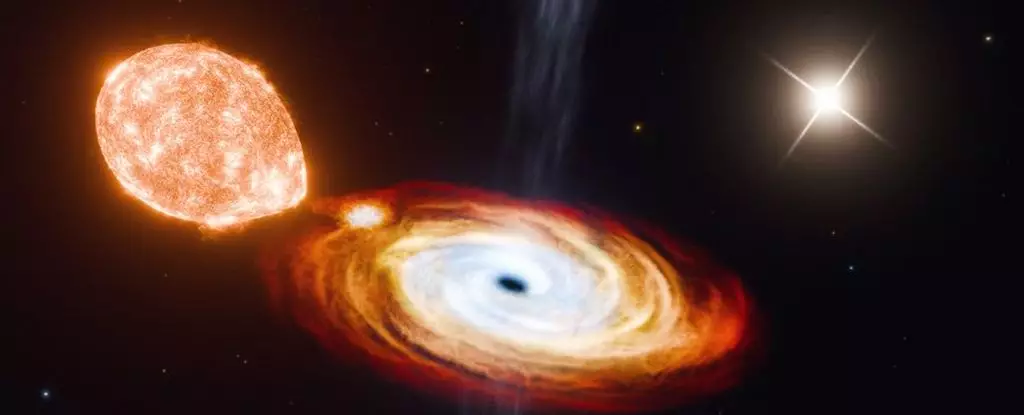Located approximately 7,800 light-years away in the constellation of Cygnus, the black hole system known as V404 Cygni has intrigued astronomers for years with its bizarre behaviors and phenomena. Recently, new discoveries related to this intriguing trinary system have sparked a revolution in our understanding of black hole formation and evolution. The revelation of a companion star orbiting V404 Cygni over a staggering 70,000-year time frame adds a compelling layer to our comprehension of cosmic events that have long been shrouded in mystery.
V404 Cygni is not just any black hole; it harbors an existing companion star in a close orbit, marking a binary configuration. However, the identification of an additional third star with a much wider orbital distance means that astronomers are now dealing with a trinary system. This discovery is groundbreaking because it is the first of its kind, challenging traditional notions of stellar relationships and dynamics. Astronomer Kevin Burdge from the Massachusetts Institute of Technology emphasizes the importance of this finding, noting that it may provide significant insights into the mechanics of black hole formation.
The recent revelations stem from data collected by the European Space Agency’s Gaia mission, which is dedicated to mapping the Milky Way’s three-dimensional layout and the motions of its stellar inhabitants. As the data began to unfold, it became clear that the stars within the V404 Cygni system were intricately linked, moving in unison and confirming their gravitational connection. The confluence of these elements raises intriguing questions about the historical formation processes of black holes.
Historically, the prevailing model for black hole formation has revolved around supernova explosions. In this classical scenario, a dying star detonates in a brilliant explosion, ejecting its outer layers while its core collapses to form a black hole. However, the newly identified trinary configuration draws attention to the validity of alternative models, particularly the direct collapse mechanism. This method posits that massive stars may implode instantaneously into black holes without the explosive aftermath.
The evidence supporting the traditional supernova model remains robust, with scientists having observed numerous supernovae and analyzed the light emitted to infer the resulting black hole’s properties. Yet, the peculiar orbital dynamics of V404 Cygni beg for deeper exploration into the mechanisms of its formation, especially given that the distance between the black hole and its newly discovered companion is vast—approximately 3,500 astronomical units. Such a separation typically weakens the gravitational bond necessary for the survival of both entities if a supernova were to occur.
Simulation Insights and New Paradigms
Burdge and his collaborators embarked on a series of simulations to explore the dynamics of V404 Cygni. Their findings suggest that the simplest explanation for the existence of this trinary system is that the stars were initially gravitationally bound before the formation of the black hole. The simulations consistently pointed toward the direct collapse model as the most plausible means for constructing this unique configuration.
This compelling evidence revitalizes interest in the direct collapse theory and emphasizes its validity as a pathway for understanding other black holes that defy traditional formation narratives. The characteristics of V404 Cygni could hint at a larger set of black hole systems in the universe—ones that might similarly exhibit peculiar orbital arrangements yet have remained overlooked due to the stealthy nature of black holes.
The discovery of V404 Cygni’s trinary system not only enriches our theoretical frameworks but also opens up new avenues for future research. As scientists strive to uncover more about black holes and the conditions conducive to their formation, the potential existence of similar configurations may reshape our understanding of stellar evolution and dynamics. Kareem El-Badry from Caltech speculates, “If these trinary systems are common, they could help unravel long-standing questions about binary black hole formation and their evolutionary pathways.”
In essence, the implications of this discovery extend far beyond V404 Cygni itself. The nuances of black hole formation may lie within these intricate stellar relationships, offering astronomers new tools to interpret the enigmatic behavior of such celestial phenomena.
The unfolding saga of V404 Cygni exemplifies the relentless curiosity that drives astronomical exploration. As researchers continue to analyze data and theories surrounding black hole formation, the recognition of trinary systems like V404 Cygni may redefine existing paradigms of cosmic evolution. As we peer deeper into the universe’s fabric, insights gained from such discoveries will enrich our understanding of the cosmos, asserting that there is always more to learn within the depths of space.


Leave a Reply